Fallingwater was the jewel in the crown of our trip, but although it was magnificent, it wasn't appealing. It was built as a weekend retreat for the wealthy Kaufmann family. As a great place to have a house party, it couldn't be beat. As a place you might want to live, not so much.
There have been many books written about this house (I read several of them preparing for the trip). I can only cover snippets about what we saw. Wright received the commission at a rock-bottom time of his career. He was widely considered a has-been. With this house he became a phoenix rising from the ashes. The resulting structure is widely considered to be one of the best designs in the USA if not the world.
It was an unexpected treat to have a private dinner at the visitors' center . The food was tasty and the evening was lovely. The only thing that could have made it better was having seats with an overview of the house!
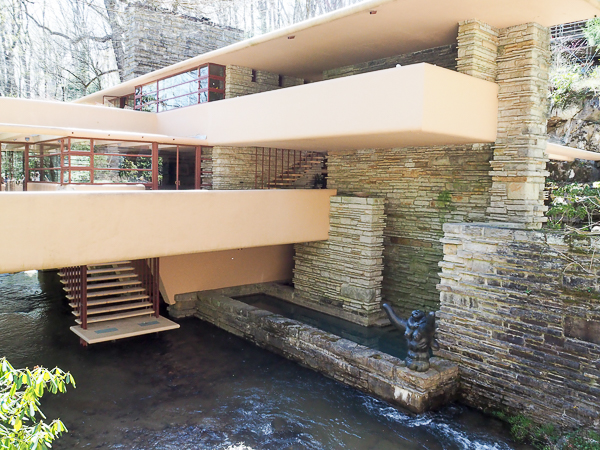
We approached the house by way of the bridge over Bear Creek.
When the house was being designed, the owner, Edgar Kaufmann, consulted with many outside engineers about the radical design. They panned it. The cantilevered terraces wouldn't last. The house was too close to the water. It would wash away.
Eighty-six years later the house is still standing ... not that there haven't been a few floods and other problems.
If you want to know details about how the building has been preserved and conserved, just Google "saving Fallingwater" and choose one or more of the many returned options. The short version is that the two large terraces shown in this picture were in imminent danger of collapse. The initial engineering design was in fact flawed, but work completed in 2022 has addressed the issues and the house should stand for many more years. Click to learn more about ongoing restoration efforts.
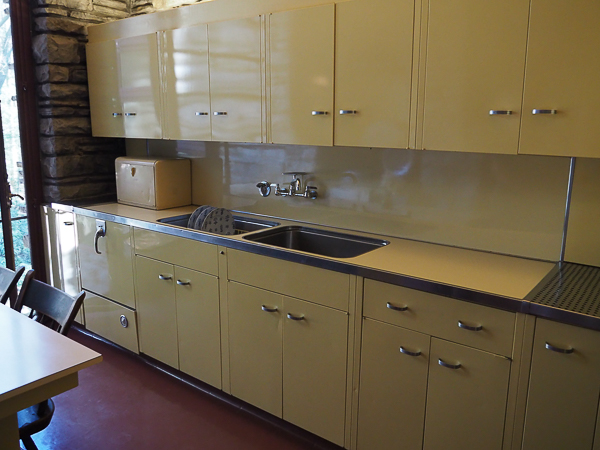
We had already seen spacious Wright-designed kitchens in Usonian houses. This is the kitchen at Fallingwater where the cooking staff designed and prepared lavish meals for 50 or more guests. On the left of the glass doors was the stove, an Aga. That was it.
It seems classist. If Mom is preparing the meal for hubby and 2.4 children, she gets plenty of space; if "staff" is preparing the meal for the employer's family and a passel of their best friends, they get a cubbyhole in the basement. Really?
One of the treats of the week was a recorded interview with the Kaufmann's long-time cook. She loved working for the family. Perhaps in part because she got paid for full-time work, but only had to work on occasional weekends. I suppose it evens out.
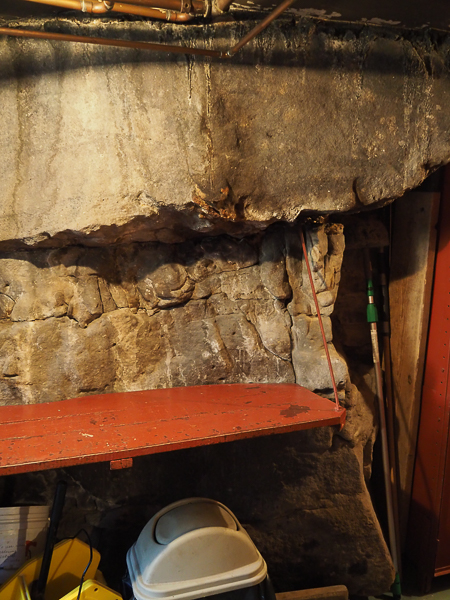
When I said the kitchen was in the basement, that was not an exaggeration. This wall was just to the right of the cabinets in the picture above. Narrow and steep stairs to the right of this boulder led to the main floor of the house. Food was carried up when ready. There was no such convenience as a dumb-waiter.
One of our group insisted that there must be a "real" kitchen tucked away somewhere else in the house, but our guide assured us there was not.
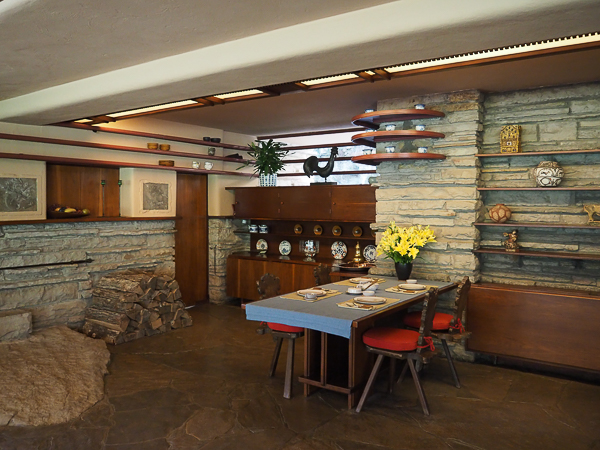
This is a corner of the living/dining room.
Fallingwater is unique in that it contains most of the Wright-designed furniture as well as the built-ins. It also contains original Kaufmann artwork. When the Kaufmann's son donated the house and land to the Western Pennsylvania Conservancy, he included all the contents.
Presumably having heard stories of Wright-designed chairs, the Kaufmann family chose to procure their own chairs -- three-legged ones as shown here. I'm not sure these would have been an improvement!
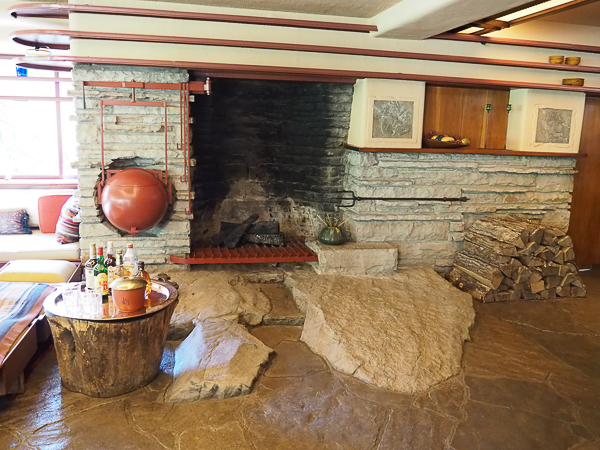
The hearth at Fallingwater sits directly on top of the boulders forming the foundation of the house. They are exposed here.
The globe is a device for mulling wine. It swings into the fireplace. That must have fueled some memorable (or maybe not) celebrations!
I didn't take pictures of the sunny and wide-open living room. Google "Fallingwater interior photos" to find as many as you like. It was indeed a great party venue.
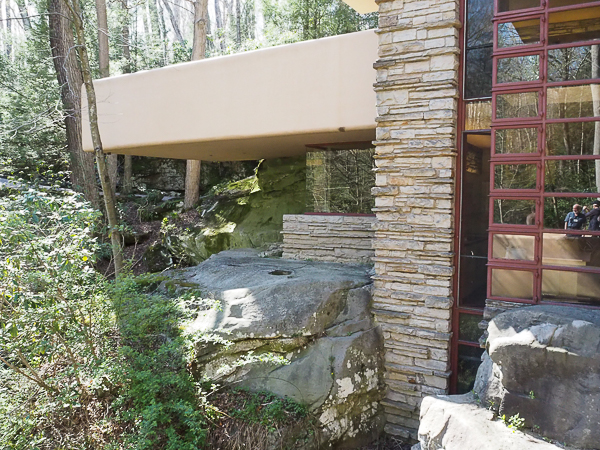
The view from the main terrace towards Mr. Kaufmann's bedroom terrace shows again how the house was integrated into the huge boulders above the falls.
The story goes that Wright, who only visited the site once before the house was built, had commissioned a detailed topographic study of the area. And then did nothing with it.
When Mr. Kaufmann, getting impatient to hear of progress, informed Wright that he would be visiting Taliesin and was eager to see how the plans were developing, Wright was delighted. And did nothing but dig out the site plan and occasionally look at it passing.
Finally when Mr. Kaufmann called to say he would be arriving for lunch that day, Wright sat down, whipped out his straightedge and compass and drafted the multi-level floor plans in about a three-hour span of time. He then gave the plans to his apprentices and told them to produce the elevations while he had lunch with "E.J."
The fact that E.J. was expecting a house with a VIEW of the falls rather than one perched OVER the falls, was of no consequence to Wright.
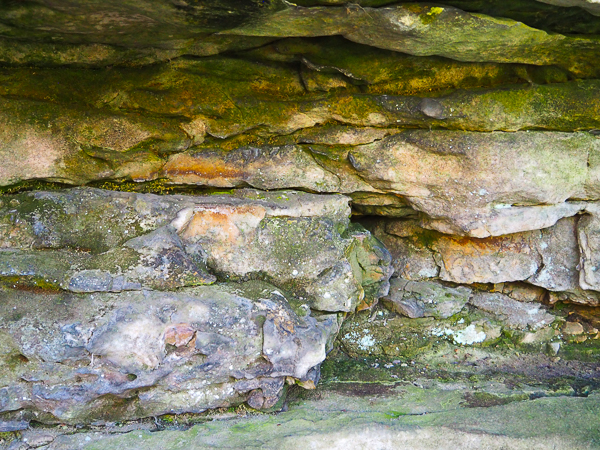
The house is constructed of "Pottsville" sandstone quarried at the site. The natural form of the stone shown here suggested the layers of the built masonry.
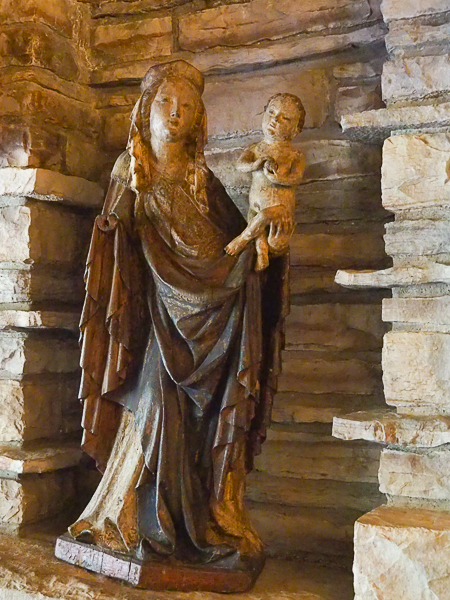
In some cases the design of the house showcased artwork in the Kaufmann's collection.
Wright designed this niche especially for this 15th century Madonna and child beloved by Mrs. Kaufmann.
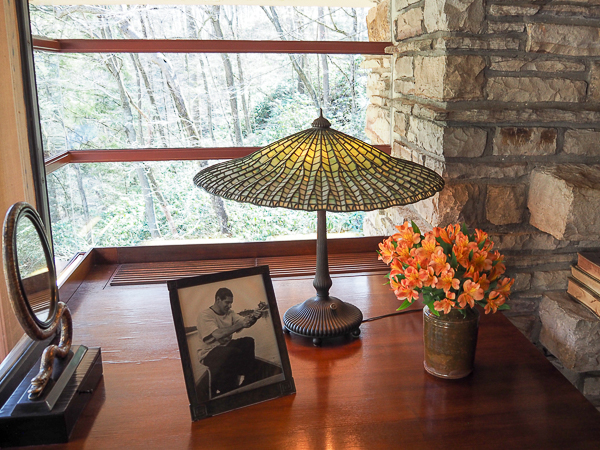
One of Wright's innovations was the use of "disappearing corner" windows. The use of cantilevers meant that there was no need for structural corners.
Other corner windows at Fallingwater have a metal framework that "disappears" when the window is open.
The picture on the desk is of Kaufmann Junior, who donated Fallingwater.
Both the picture frame and the lamp are by Tiffany.
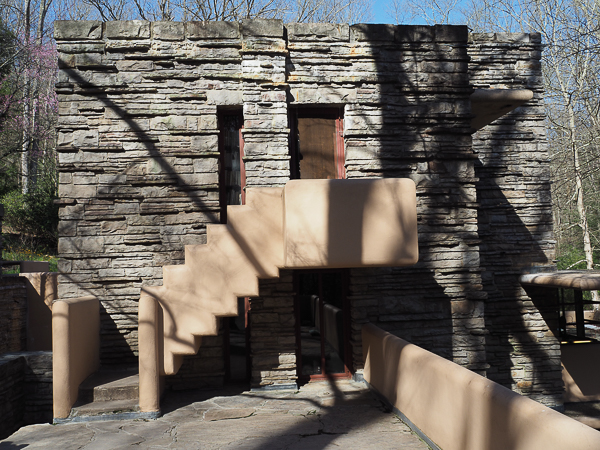 "Junior" had his own bedroom suite perched high above the rest of the
house.
"Junior" had his own bedroom suite perched high above the rest of the
house.
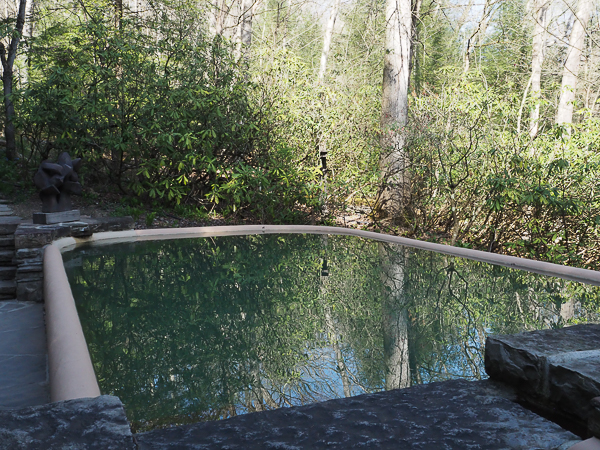
The family wanted a swimming pool, but Wright resisted. Eventually a "plunge pool" was created down by the stream and this small pool adjoined Junior's terrace.
Even though Junior's room was four stories above the base of the house, it is still at ground level. Wright thought difficult sites spurred his creativity.
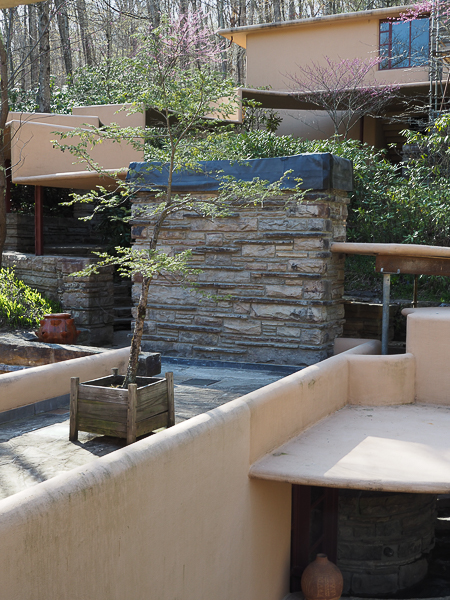
The cascading levels of the house echo the cascades of the stream.
The structure on the upper right is the guest house, added later. It is reached by a covered walkway with a stepped roof that angles up the hill on the left of the image.
The entrance to the main house is under the canopy on the lower right. Wright always managed to hide his entrances for a feeling of increased privacy.
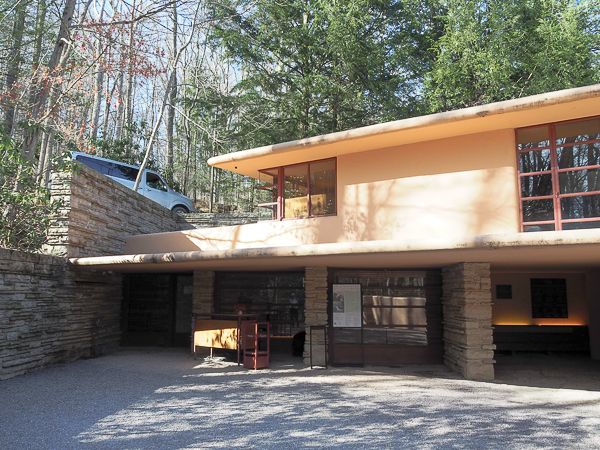
The servants had their own space even farther up the hillside. This building is now used for offices.
The Kaufmanns allowed the staff to host their own parties at the house when the family was not using it. Apparently there were some good celebrations, but the workers were respectful of their employers and didn't abuse the privilege.
As elsewhere Wright used carports rather than garages.
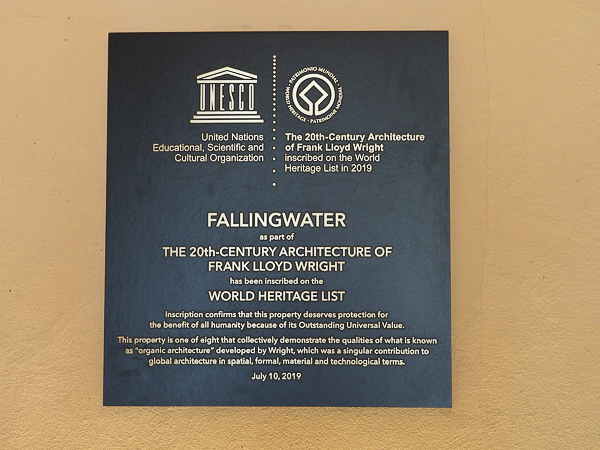
In 2019 after several years of effort, a collection of Wright-designed buildings were added to the UNESCO World Heritage List. The buildings span the years from 1906 to 1956.
One of the most interesting presentations of the week was about UNESCO, the World Heritage List, and the politics and policies around them. The creation of the list was spurred by the destruction caused by the Aswan High Dam in Egypt in the 1960s. Twenty-two monuments were relocated above the water, but an unknown amount of context and future archeological information was lost.
There are a number of criteria that must be met to be included. The one that surprised us was that a site ALREADY had to be protected and have an active management structure. That made it difficult for Wright's work to be included since much of it is still in private hands.
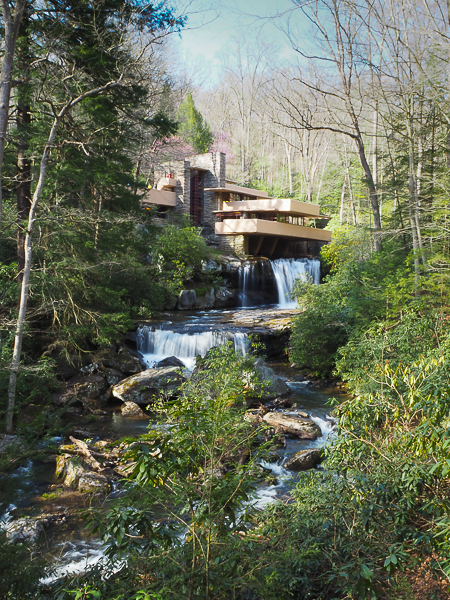
The iconic image of Fallingwater is taken from farther up the Bear Creek gorge, but it doesn't give the complete picture of the cascade.
We were visiting after a week of significant rainfall, so the creek was quite full.
Had we visited later in the year when the rhododendron and mountain laurel were blooming, the view would have been even more spectacular, but this ain't so shabby as it is.
Click your "back" button to return to the previous page or click for our picture album.